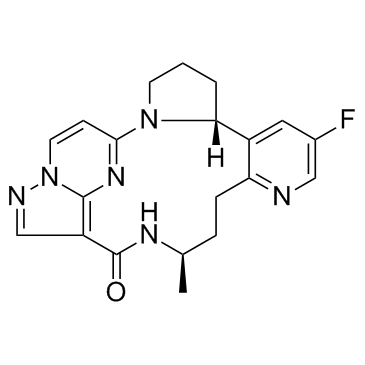2097002-61-2
| Name | 0J45910S3X |
|---|---|
| Synonyms |
12H-15,17-Ethenopyrazolo[3,4-d]pyrido[2,3-k]pyrrolo[2,1-m][1,3,7]triazacyclotridecin-12-one, 5-fluoro-1,2,3,3a,8,9,10,11-octahydro-10-methyl-, (3aR,10R)-
(6R,15R)-9-Fluoro-15-methyl-2,11,16,20,21,24-hexaazapentacyclo[16.5.2.02,6.07,12.021,25]pentacosa-1(24),7,9,11,18(25),19,22-heptaen-17-one 0J45910S3X LOXO-195 |
| Description | LOXO-195 is a next-generation TRK kinase inhibitor (TKI), with IC50s of 0.6 nM, <2.5 nM for TRKA and TRKC respectively. |
|---|---|
| Related Catalog | |
| Target |
TrkA:0.6 nM (IC50) TrkC:<2.5 nM (IC50) |
| In Vitro | LOXO-195 demonstrates strong binding to the wild-type TRKA, TRKB and TRKC kinase domains. LOXO-195 has potent (IC50<1 nM) inhibitory activity in kinase enzyme assays. Importantly, LOXO-195 achieves low nanomolar inhibitory activity against TRKA G595R, TRKC G623R, and TRKA G667C, with IC50s ranging from 2.0-9.8 nM. 228 individual kinases in vitro are profiled at a LOXO-195 concentration of 1 μM, which is ~1667-fold higher than its IC50 for TRKA (0.6 nM). LOXO-195 is more than 1000-fold selective for 98% of non-TRK kinases tested. LOXO-195 demonstrates potent inhibition of cell proliferation in TRK fusion-containing KM12, CUTO-3, and MO-91 cell lines (IC50≤5 nM)[1]. |
| In Vivo | Stably transfected NIH-3T3 ΔTRKA and ΔTRKA-G595R cells are implanted subcutaneously into the flanks of nude mice. Both larotrectinib and LOXO-195 are effective at reducing phosphorylated TRKA in tumors driven by ΔTRKA. In contrast, only LOXO-195 strongly suppresses phospho-TRKA in ΔTRKA-G595R cells in a dose-dependent manner. LOXO-195 also causes inhibition of tumor growth relative to vehicle at all doses in four TRKA-dependent tumor models (ΔTRKA, ΔTRKA-G595R, ΔTRKAG667C, and TPM3-NTRK1 fusion-positive KM12 colorectal cancer cells. Larotrectinib inhibits KM12 and NIH 3T3-ΔTRKA tumors to a similar degree. Group mean body weight loss does not exceed 5% for any agent. LOXO-195 displays high selectivity for the TRK proteins[1] |
| Cell Assay | For assessment of cellular inhibition potency, cells are harvested per a standard protocol, counted and added to flat-bottom, collagen I-coated 96-well assay plates at 3×104 cells/well (wild-type cell line) or 5×104 cells/well (mutant cell lines) in 100 μL/well of DMEM growth medium containing 10% FBS. Plates are then incubated at room temperature for 30 minutes prior to an overnight incubation at 37°C with 5% CO2. Next, cells are treated for 1 hour at 37°C, 5% CO2 with TRK inhibitor compounds (e.g., LOXO-195). Control wells contain either 0.25% DMSO alone or 1 μM larotrectinib or LOXO-195. Following compound incubation, growth medium is discarded and cells are lysed by addition of 60 μL/well of ice-cold lysis buffer containing protease and phosphatase inhibitors[1]. |
| Animal Admin | Mice[1] The ΔTRKA, ΔTRKA-G595R, and ΔTRKA -G667C NIH-3T3 tumor cell lines (~2-3x106 cells) and KM12 cells (5x106 cells) are injected subcutaneously into the right flank of female nu/nu NCr mice. Tumors are allowed to grow to ~100-200 mm3 or ~500 mm3, and animals are randomized by tumor size into dosing groups of 5 (KM12), 7 (NIH 3T3 ΔTRKA variants) or 3-4 (for PK-PD) animals. Animals are dosed by oral gavage with vehicle, LOXO-195 in 1% carboxymethylcellulose/0.5% Tween-80 or larotrectinib in 100% Labrafac lipophile. All animals are obtained at 6-8 weeks of age, housed in groups of 5 and allowed a one-week acclimation period before cancer cell injection. Animals are dosed with vehicle twice daily, LOXO-195 at 30 mg/kg, 100 mg/kg and 300 mg/kg twice daily and larotrectinib at 60 mg/kg daily for 9-12 days. Body weight and tumor size are monitored after cell implantation and at regular intervals during dosing[1]. |
| References |
| Density | 1.5±0.1 g/cm3 |
|---|---|
| Molecular Formula | C20H21FN6O |
| Molecular Weight | 380.419 |
| Exact Mass | 380.176086 |
| LogP | 2.27 |
| Index of Refraction | 1.751 |
